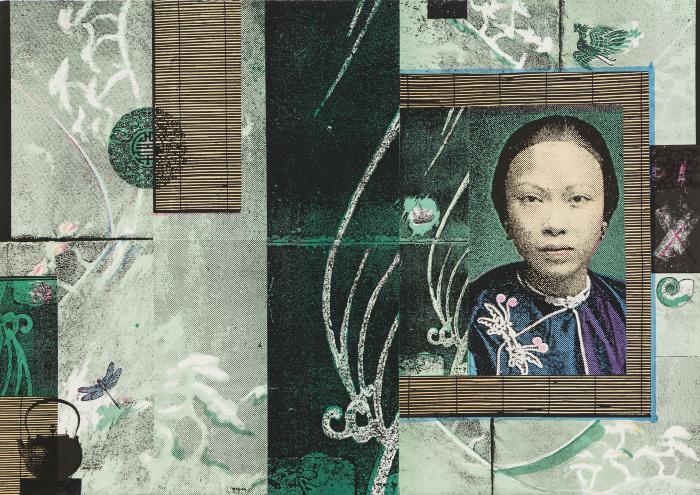
Portrait of a Young Woman
Tomie Arai
- 1998
- Offset Lithograph
- Image/sheet: 22 x 30"
- 100 prints in this edition
About the Print
From the Artist
As an Asian American artist, I am primarily interested in locating the human experience in historic events and drawing personal meaning from the past. Toward this end, I have relied heavily on firsthand accounts, family archives, and historic photographs to create new narratives about the Asian diaspora in the Americas. These visual narratives help me to explore the relationship between memory, art, and history and provide a personal sense of connection to the world around me.
Portrait of a Young Woman is one of a series of portraits I have created which were based on archival photographs. Through the use of autobiography, family stories and photographs, historical material and oral histories, I create works on paper/pages of “living” history centered in the experiences of people whose voices have not been heard.
Throughout my work, visual references are made to the screens, scrolls and motifs found in traditional Asian art. These references serve as a link between the past and the present, the exotic and the ordinary, and the foreign and the familiar. As a visual artist, I use the specificity of my experience as an Asian American as a personal space in which to locate broader issues of race and gender; a space through which a glimpse of common ground is made possible.Unlike many younger artists who developed their love of printmaking as students in university printmaking departments, I learned how to etch and silkscreen from working alongside other artists in shops like Bob Blackburn’s Printmaking Workshop and the Lower East Side Printshop in the 1970s—unconventional workspaces and printmaking centers for artists experimenting with the printed image.
Brandywine Workshop provided the added experience of a residency embedded in South Philadelphia which gave artists the time and space to engage in creative collaborations with their professional offset printers.
Because of my rich history with these shops, printmaking has always been tied closely to the notion of an artist community supported and energized by the existence of these important non-profit work spaces. At a time when printmaking, as a genre, has been displaced by digital technology, I am grateful to Brandywine Workshop for keeping printmaking alive, and for continuing to give printmakers one of the finest opportunities to share their work and their collective vision for a more diverse and equitable art world.
—From Brandywine Workshop and Archives records
About the Artist
Born in New York City, Tomie Arai has designed both temporary and permanent public works of art for the New York City Percent for Art program, Creative Time, Metropolitan Transit Authority (MTA) Arts & Design program, New York City Department of Education, and Lower Manhattan Cultural Council, all in New York City; United States General Services Administration Art in Architecture Program, Washington, DC; Cambridge Arts Council, MA; and the San Francisco Arts Commission.
Arai’s work has been exhibited nationally and her work is in public collections including the Library of Congress, Washington, DC; Bronx Museum of the Arts, Museum of Modern Art, and Whitney Museum of American Art, New York City; Japanese American National Museum, Los Angeles; and Williams College Museum of Art, Williamstown, MA. She is a recipient of two New York Foundation for the Arts Fellowships, a Joan Mitchell Foundation Grant, a National Endowment for the Arts Fellowship, and three Mid Atlantic Arts Foundation Artists Residency Grants.
In 2000, Arai was one of 50 artists nationwide to participate in the Artists & Communities: America Creates for the Millennium project, sponsored by the Mid Atlantic Arts Foundation and the National Endowment for the Arts. She also received a National Lifetime Achievement Award from the Women’s Caucus for Art in 2016. In 2019 she received the McLaughlin Award for Social Engagement. Arai lives and works in New York City.
—From Brandywine Workshop and Archives records
Curriculum Connections
Suggested Topics for Literature and Creative Writing
Creativity in response to Oppression
Marginalization, a form of oppression, assumes that an individual’s ability to perform a job is determined by their identity (Latin Americans are gardeners, African Americans are domestic servants, women are clerical assistants—while Native Americans are not seen as individuals, living human workers but as symbolic mascots for sports teams, etc.). In response to oppression, artists marshal their creative work as forms of resistance. Leaders like Martin Luther King advocated that the most potent forms of resistance were nonviolent. The arts are especially effective forms of nonviolent resistance as they give voice to the human spirit, emphasize our shared humanity, present startling juxtapositions by showing how oppression creates brutal realities for some and pleasure for others, and inscribe iconic aesthetic images that reverberate in our contemporary awareness and historical imaginations. Let’s explore how we feel about ourselves and our community role based on our passion, talents, background, and location.
Questions to Consider
- How do we define ourselves?
- In what ways do others define us?
